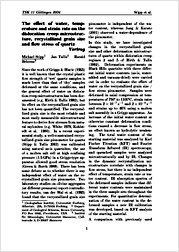The effect of water, temperature and strain rate on the dislocation creep microstructure, recystallized grain size and flow stress of quartz
Stipp, Michael
Tullis, Jan
Behrens, Harald
Universitätsverlag Göttingen
Sammelband- / Konferenzbeitrag
Verlagsversion
Deutsch
Stipp, Michael; Tullis, Jan; Behrens, Harald, 2006: The effect of water, temperature and strain rate on the dislocation creep microstructure, recystallized grain size and flow stress of quartz. In: Philipp, S.; Leiss, B; Vollbrecht, A.; Tanner, D.; Gudmundsson, A. (eds.): 11. Symposium "Tektonik, Struktur- und Kristallingeologie"; 2006, Univ.-Verl. Göttingen, p. 222 - 224., , DOI: 10.23689/fidgeo-1931.
 |
Dokument öffnen: |
Since the work of Griggs & Blacic (1965)
it is well known that the crystal plastic
flow strength of ‘wet’ quartz samples is
much lower than that of ‘dry’ samples
deformed at the same conditions, and
the general effect of water on dislocation
creep microstructures has been documented
(e.g. Hirth & Tullis 1992), but
its effect on the recrystallized grain size
has not been quantified. The recrystallized
grain size is the most reliable and
most easily measurable microstructural
feature to derive flow stresses from natural
mylonites (e.g. White 1979, Kohlstedt
et al. 1980). In a recent experimental
study, a well-constrained recrystallized
grain size piezometer for quartz
(Stipp & Tullis 2003) was calibrated
using natural as-is quartzites; the use
of a molten salt cell at high confining
pressure (1.5GPa) in a Griggs-type apparatus
allowed good stress resolution
(Green & Borch 1989). There has been
some debate as to whether there is any
independent effect of water on the recrystallized
grain size piezometer. Two
laboratory studies on olivine aggregates
(at different pressures) report contradictory
results; van der Wal et al. (1993)
found that the recrystallized grain size
piezometer is independent of the water
content, whereas Jung & Karato
(2001) observed a water-dependence of
the piezometer.
In this study, we have investigated
changes in the recrystallized grain
size and other deformation microstructures
of quartz within dislocation creep
regimes 2 and 3 of Hirth & Tullis
(1992). Deformation experiments on
Black Hills quartzite with three different
initial water contents (as-is, wateradded
and vacuum-dried) were carried
out in order to evaluate the effect of
water on the recrystallized grain size /
flow stress piezometer...

